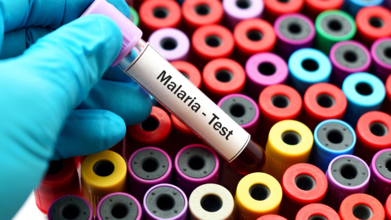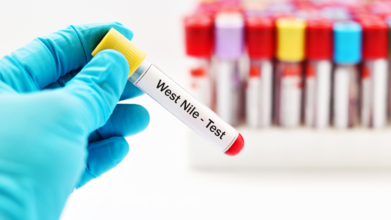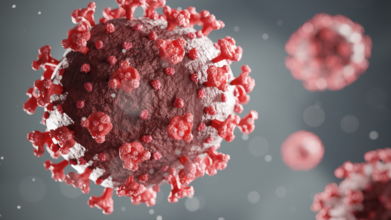- Health Conditions A-Z
- Health & Wellness
- Nutrition
- Fitness
- Health News
- Ayurveda
- Videos
- Medicine A-Z
- Parenting
- Web Stories
Delhi Malaria Cases Increase, Highest Number Of Cases In 5 Years

(Credit-Canva)
After a day of heavy rain, Delhi is facing a serious health concern, a sharp rise in mosquito-borne illnesses. With waterlogged streets and poor drainage, malaria cases have hit a five-year high. According to the latest data, 135 cases were reported from January 1 to August 2, marking the highest number for this period in the last five years.
What Areas In Delhi Are Seeing A Rise In Malaria Cases?
The city of Delhi is seeing a worrying increase in malaria cases. The West Zone of the city has been hit the hardest, with 30 confirmed cases. This recent data comes from different parts of Delhi, including areas managed by the New Delhi Municipal Council, Delhi Cantt, and Indian Railways.
As of August 2nd, the number of malaria cases has been growing year after year, with this year’s total of 135 cases being the highest in the last five years for the same period. City officials say this is happening because of a "perfect environment for mosquitoes to breed." They have found that common places where mosquitoes are growing include water-filled coolers, flower pots, drums, and even old tires left on rooftops.
Vector-Borne Diseases Also a Concern
Malaria is a serious, life-threatening disease common in tropical countries. It is spread to people through the bite of certain types of infected mosquitoes. The good news is that malaria is both preventable and curable. Unfortunately, malaria isn't the only mosquito-related problem. Two other diseases carried by mosquitoes are also on the rise:
Chikungunya: So far this year, there have been 20 cases. The West and Central Zones of the city have each reported five cases. This is a noticeable jump from previous years, with a total of 267 cases reported in all of 2024.
Dengue: The city has also seen 291 cases of dengue. The Central Zone has the most cases, with 39. Last year, 11 people sadly died from this disease.
To fight this problem, health officials have been inspecting homes. They've found that mosquitoes are breeding in over 100,000 houses and have sent out around 76,000 legal notices to residents to clean up these spots.
Why Should Malaria Be A Cause Of Concern For People?
According to IJID Regions journal, Malaria remains a significant health challenge in India, with about 1.3 billion people at risk and over 180,000 cases reported in 2022. The Indian government has been working hard to control and reduce the number of malaria cases. This report looked closely at these efforts and found that several programs have been successful.
The Urban Malaria Scheme, which focuses on 131 cities, and the Intensified Malaria Control Project, which targets seven high-risk areas, have both been very effective.
A newer plan, the National Framework for Malaria Elimination, has also helped reduce cases in states like Odisha, which was once a major hotspot for the disease.
How to Stay Safe from Malaria?
If you think you have malaria, it's essential to get tested right away with a simple blood test. Early treatment can stop a mild case from becoming severe. Doctors will prescribe specific medicines based on the type of malaria and the person's age and health.
A major challenge in fighting malaria today is that the parasites and mosquitoes are becoming resistant to our medicines and insecticides. Scientists are working on new solutions, like new-generation mosquito nets and updated treatment plans, to combat this resistance and keep the disease under control.
You can protect yourself from malaria by avoiding mosquito bites and taking special medication, especially if you are traveling to an area where malaria is common. To avoid mosquito bites:
- Use mosquito nets when you sleep
- Wear protective clothing like long sleeves and pants.
- Use mosquito repellent on your skin.
- Install screens on your windows and doors.
First West Nile Virus Case Confirmed In Michigan: How Does The Infection Spread Through The Body?

(Credit-Canva)
The Michigan Department of Health and Human Services has announced the first confirmed human case of West Nile virus (WNV) for 2025. The infected person is a resident of Livingston County, though no other details were released. The first case in 2024 was also found in Livingston County.
According to Michigan's chief medical executive, Dr. Natasha Bagdasarian, it only takes a single bite from an infected mosquito to cause a severe illness. She advises people to use insect repellent and wear long-sleeved shirts and pants when outside, especially from dusk to dawn, when mosquitoes are most active.
So far this year, mosquitoes with the virus have also been found in several other counties, including Bay, Kalamazoo, Kent, Macomb, Midland, Saginaw, Tuscola, and Wayne.
What Is West Nile Virus?
The Centers of Disease Control and Prevention (CDC) explains that west Nile virus is the most common disease spread by mosquitoes in the continental United States. It is passed to people through the bite of an infected mosquito. The risk of getting the virus is highest during mosquito season, which typically runs from summer through fall. There is currently no vaccine or specific medicine to treat West Nile virus in humans.
What to Expect if You're Infected With West Nile Virus
Most people who get West Nile virus (about 4 out of 5) will not feel sick at all. About 1 in 5 people will develop what is called West Nile fever, with symptoms that can include:
- A fever and headache
- Body aches and joint pain
- Vomiting or diarrhea
- A skin rash
These symptoms usually last a few days to a few weeks, and most people recover on their own. However, a small number of people, about 1 in 150, will get a serious and sometimes deadly illness. This happens when the virus causes inflammation of the brain (encephalitis) or the lining of the brain and spinal cord (meningitis). Symptoms of this more severe illness include:
- A high fever
- A stiff neck
- Confusion or disorientation
- Seizures or paralysis
- A coma
Who Is at Risk for West Nile Virus?
Your risk of getting West Nile virus goes up if you are exposed to mosquito bites during the summer.
While most people who get infected have a mild illness and recover completely, certain people are more likely to get a serious illness from the virus. This includes older people and those with weak immune systems.
If a healthcare provider thinks you might have West Nile virus, they will likely order a blood test. This test looks for signs in your blood that your body is fighting the virus. In more serious cases, they may also perform a spinal tap (lumbar puncture) to check the fluid around your brain and spinal cord for signs of infection.
How Is West Nile Virus Treated?
There is no specific medicine to cure West Nile virus. Treatment focuses on managing your symptoms and supporting your body while it fights the infection. For the most serious cases, such as West Nile encephalitis or meningitis, a person may need to stay in the hospital for intensive care. This care can include:
- Getting fluids through an IV
- Using a breathing machine (ventilator)
- Receiving care to prevent other infections, like pneumonia
- General nursing care
How to Protect Yourself from Mosquito Bites
The CDC explains that since there is no treatment for the virus, the best way to protect yourself is to prevent mosquito bites. You can do this by:
Using bug repellent
Look for products that are approved by the Environmental Protection Agency (EPA). The most effective repellents contain ingredients like DEET, picaridin, or oil of lemon eucalyptus.
Getting rid of standing water
Mosquitoes lay their eggs in water, so you should remove any standing water around your home. This includes water in buckets, tires, birdbaths, and flowerpots.
Wearing protective clothing
When you are outside, especially from dusk to dawn when mosquitoes are most active, wear long-sleeved shirts and long pants.
Study Finds Controlling Inflammation In Diabetics Could Treat Depression, With Approaches Differing

Living with diabetes is already challenging enough, and it comes with depression. Scientists say people with diabetes are up to twice as likely to experience depressive symptoms compared to those without it. But a new study suggests that controlling inflammation in the body could help treat depression in diabetics. However, the best approach depends on the type of diabetes you have.
The Two Types
Type 1 and type 2 diabetes are not the same. The latter is mostly known for the body’s inability to manage blood sugar effectively. In type 1 diabetes, on the other hand, the immune system attacks the insulin-producing cells in the pancreas, leaving the body without its natural blood sugar control.
Researchers have long known that both types can affect mental health. But this new work, published in the journal Diabetologia, suggests that the kind of inflammation happening in your body could hold the key to finding the most effective treatment for depression.
Diabetes and depression often form a harmful feedback loop. High blood sugar can trigger fatigue and brain fog, depression can lead to poor self-care, and the cycle rolls on. Add inflammation to the mix, a biological response that can affect brain chemistry, and it becomes even harder to break free from the spiral.
The Study
The researchers from the Research Institute of the Diabetes Academy Mergentheim (FIDAM) in Germany decided to explore exactly how inflammation affects the success of depression treatments in people with diabetes. They measured 76 different inflammatory markers in the blood of 521 participants with type 1 or type 2 diabetes, all of whom were being monitored for depressive symptoms over a year.
Behavioural Therapy Works But Not the Same for Everyone
One of the main treatments tested was cognitive behavioural therapy (CBT), a structured form of psychotherapy that focuses on changing unhelpful thought patterns.
For people with type 2 diabetes and high inflammation levels, CBT worked wonders, reducing symptoms like joylessness and helping patients shift towards more positive thinking.
But for those with type 1 diabetes and similarly high inflammation levels, CBT didn’t have the same magic. Improvements were smaller, especially for symptoms like fatigue, trouble sleeping, or loss of appetite. This suggests that the underlying biology, in this case, the type of inflammation, plays a huge role in determining whether a therapy hits the mark.
Why the Difference?
The researchers believe it comes down to the nature of the inflammation. In type 2 diabetes, inflammation is largely metabolic, a consequence of the body’s inability to handle blood sugar properly. In type 1 diabetes, the inflammation is autoimmune; the immune system itself is attacking parts of the body.
These two processes likely influence the brain and mood in different ways, which might explain why CBT was a better fit for type 2 diabetics, while type 1 diabetics with high inflammation could benefit more from treatments aimed at reducing inflammation directly, such as anti-inflammatory drugs.
The Numbers Don’t Lie
The data revealed an intriguing split. In people with type 2 diabetes, higher levels of 26 biomarkers were linked to bigger improvements in depression symptoms after CBT. In type 1 diabetes, higher levels of 13 biomarkers were actually linked to smaller improvements.
This is more than a curious statistic; it could be the basis for personalised mental health care in diabetes. Instead of trying the same approach for everyone, doctors might one day test inflammation markers first, then choose the right therapy based on each patient’s biological profile.
Why This Matters
For diabetics, depression isn’t just an emotional burden; it can directly affect physical health. Low mood can make it harder to stick to a treatment plan, exercise, or eat well. Addressing both conditions at once could lead to better long-term health outcomes.
As study author Norbert Hermanns says, people with type 2 diabetes and high inflammation levels possibly respond particularly well to a change in depressive cognitions through cognitive behavioural therapy. People with type 1 diabetes and high inflammation levels, on the other hand, could benefit more from anti-inflammatory drug therapies.
The right combination of physical and mental health treatments could help patients feel better faster.
The Future of Tailored Treatments
The idea of personalised medicine is gaining traction in all areas of healthcare, and this research shows why. In the future, doctors could run a simple blood test, see which inflammatory markers are elevated, and then decide whether a patient might do best with therapy, medication, or both.
Surge in ‘Stratus’ Covid-19 Cases in the US: CDC Report Says, What Are The Symptoms?

(Credit-Canva)
The spread of COVID-19 is picking up speed this summer in the US. The key indicator of the virus shows that it's becoming more active, according to the latest data released by the Centers for Disease Control and Prevention (CDC).
How Are The Levels Of COVID Being Measure?
The CDC has a great way of tracking viruses: by checking our wastewater. This is a very helpful tool because it can find signs of the virus spreading in a community even before people start feeling sick and go to the doctor. In a recent update, the CDC reported that the amount of COVID-19 found in wastewater across the country has gone up from a "low" level to a "moderate" level.
This is a clear sign that the virus is becoming more common. The data also shows that the highest levels of the virus are currently in the Western part of the country. States like Alaska, California, Colorado, Nevada, and Utah are seeing the most activity. If you live in one of these areas, it's a good idea to be a little more careful, as the risk of getting infected is higher.
Other data also confirms the increase in cases. As of Tuesday, the CDC estimates that infections are growing or likely growing in 45 states, a jump from 40 states the previous week.
This late-summer rise is being driven in part by a new variant, XFG, or "Stratus," which is now the third-most common strain in the U.S. The variant was first found in Southeast Asia in January but didn't become a major presence in the U.S. until May. By late June, it was estimated to account for up to 14% of cases.
What Is The Current Strain Of COVID Affecting The US?
The World Health Organization explains that a new COVID-19 variant, called XFG, is now being watched closely by health experts around the world. Gavi vaccine alliance explains that Two new variants are now getting attention from scientists: NB.1.8.1, nicknamed "Nimbus," and XFG, nicknamed "Stratus."
Both variants are spreading very quickly. Since early 2025, they have spread across the globe. For example, XFG accounted for 25% of cases in Europe by late May, while NB.1.8.1 was at 11% in late April.
However, despite their rapid spread, experts say there's no evidence that these variants cause more severe illness, hospitalizations, or deaths than other versions of the virus.
XFG ("Stratus") is good at evading our immune system. It has specific mutations that help it dodge antibodies, making it harder for our bodies to fight off. However, it doesn't seem to be as good as NB.1.8.1 at infecting cells.
Is Stratus COVID Strain Dangerous?
WHO explains that the number of XFG cases is rising around the world. It’s now found in 38 countries and is growing quickly, especially in parts of Asia, the Americas, and Europe. In some countries, like India, XFG has become the main variant.
Despite this increase, experts believe the global risk of XFG is low. Early data suggests that this variant doesn’t cause more severe illness or lead to more deaths than other variants currently spreading.
Do Vaccines Work for Stratus COVID Strain?
Experts believe that the current COVID-19 vaccines will still be effective against XFG. They are expected to protect people from getting seriously sick or needing to go to the hospital.
While some countries in Southeast Asia have seen more cases and hospitalizations at the same time as XFG became more common, it's not clear if the variant itself is causing this. It's too early to say for sure how big this new wave of cases will get.
What Are The Key Symptoms of Stratus?
Doctors have reported that a standout symptom some patients with XFG have experienced a "hoarseness" feeling of scratchiness in their throat. Other symptoms include common issues like fever, chills, dry cough, fatigue, muscle ache, nasal congestion, nausea, vomiting or diarrhea.
Although XFG is spreading quickly, it doesn't appear to be more dangerous. The WHO continues to monitor them closely to see if that changes.
© 2024 Bennett, Coleman & Company Limited

